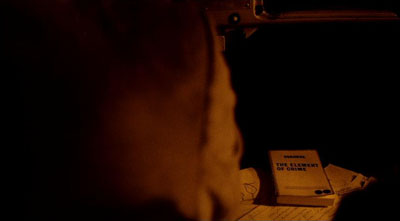The Element of Crime, 1984, directed by Lars von Trier, written by Niels Vørsel and Lars von Trier.
I rarely like dream sequences. They're usually a solution of last resort when a filmmaker needs to cram in some exposition about a character's mental state and can't find a way to do it elegantly. Even in Ratatouille—which I think is near-perfect—Linguini's nightmare about Ego doesn't add anything we don't see more clearly in other scenes. And when it comes to taking dream sequences seriously, using Freudian dream-logic to articulate things that characters hide from themselves and others, I'm with Nabokov: "Let the credulous and the vulgar continue to believe that all mental woes can be cured by a daily application of old Greek myths to their private parts." So that's dream sequences. But what about a dream movie? For me, one of the salient features of all of my nightmares is my inability to leave, that moment when you would like to wake up but are unable to. You can't capture that in two minutes of film, but you might be able to in a feature. Of course, then the question becomes, "But why would you want to?" Lars von Trier's The Element of Crime proposes an answer, but it's not exactly the one you might expect.
The film is a cinematic nightmare in at least two senses: it captures the logic of dreams in a way most films don't, and it's a singularly unpleasant viewing experience. This has a lot to do with the look that von Trier and cinematographer Tom Elling came up with, which is (I hope) unique in film history. Here's a still from early in the film, of a horse sinking in debris-strewn water:
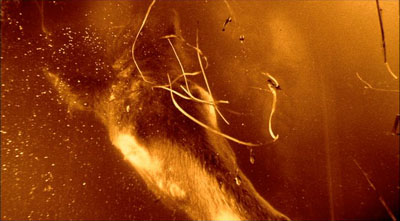
That's not a brief, strangely colored insert: the entire film is lit with that same sickly yellow. It looks like Piss Christ: The Motion Picture. Von Trier and Elling got the look by using sodium vapor lamps (now illuminating a grocery store parking lot near you), and it's unforgettable. Which is not to say it was necessarily a good idea.

Michael Elphick stars as Fisher, a man undergoing hypnotherapy in an attempt to cure his headaches. After an hour of staring at The Element of Crime's palette, I knew exactly how he felt. As the film opens, Fisher is living in Cairo, where he's apparently seeking medical care on the set of Raiders of the Lost Ark:
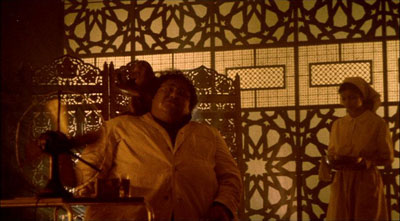
N. B.: this doctor's office is in the "real world" that opens Fisher's hypnotized memory of his last trip to Europe. So to say the film is expressionist is an understatement. Fisher's memory is a muddled pastiche of film noir and serial killer films, with a touch of Apocalypse Now thrown in for good measure. It's a bit like what T. S. Eliot might have produced instead of "The Wasteland" if he'd known film noir instead of Dante. Here's how Fisher begins telling his story:
I'm a policeman. I've finally been called back to Europe to solve a murder case.
Note that he's telling it like a dream, not a memory; he might have begun "I'm an X-wing pilot" or "I'm a trombone." The Europe he's been called back to is unrecognizeable, even to him; the first time we see him there, he's adrift in a boat, yelling that someone has "moved the fucking stairs." The murder case he's been called back about is actually cases: a serial killer has resurfaced long after his case was supposedly closed by Fisher's discredited mentor Osborne:

Osborne was a criminologist with an unconventional method that will be familiar to fans of crime movies (and which John Woo took very literally): in order to catch a criminal, you must become him. Osborne refers to his method somewhat cryptically as "the Element of Crime." To anticipate where the serial killer will next surface, Fisher duplicates a preparatory trip the killer took before his first crimes. Fisher drives the same route, stays in the same hotels, wears a hat with the killer's name on it, and even sleeps with the same woman. Does he end up identifying a little too well with the killer? Are the killer and the cop assigned to catch him, in the end, not so different? Well, I don't want to give anything away.
Although the movie predates the long string of serial killer films of the 90s, all the tropes of the genre are there. The killer has a grand design he's enacting with geometric precision:

There's the obligatory autopsy sequence with the inappropriately cheerful coroner:

There's the repurposing of things associated with childhood, from the repetitive nursery rhyme nonsense some characters mutter (e.g., "books and bother killed my mother") to the childish drawings that cover key documents like this one:
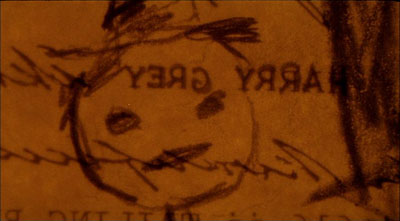
And there's even the misogyny that lurks just beneath the surface of so many of these films, mixed with more menophobia than Carrie and Superbad combined.

But if you noticed the name "Harry Grey" a few stills back, you've figured out that Von Trier's cinematic touchstones are less De Palma and more Carol Reed—apparently Harry Lime sounded too brightly colored for such a monochromatic film. Von Trier evokes Reed's Vienna throughout the film in small ways and large:
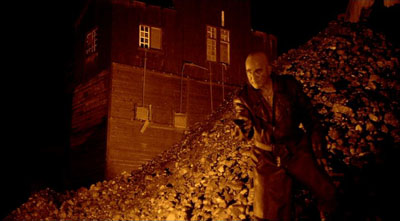
That's appropriate, since like The Third Man, The Element of Crime takes it as a given that Europe is in its last stages of moral and physical collapse. Everyone Fisher meets seems to be on their last legs, and the sets are uniformly decaying. The references to Apocalypse Now are a tougher fit, since that film dealt with such a uniquely American catastrophe. They're there, though: Jerold Wells in the still above is meant to remind you of Brando, and there's a great helicopter shot later in the film that's should have "Ride of the Valkyries" playing over it:
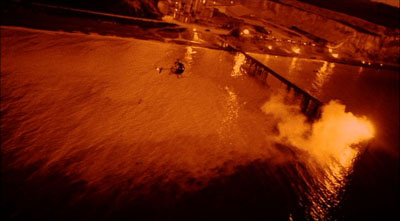
Kramer, the police chief Wells is playing, goes so far as to wander around a chaotic excavation yelling "Who's in charge of this operation?" like Willard. Finally, Von Trier tips his hat once or twice to Tarkovsky, starting with the opening shot: a donkey trying to get to its feet like the wounded horse in Andrei Rublev.
The problem with this hodgepodge of cinematic references is that they don't make the film any less tedious. Von Trier does create a pretty convincing nightmare: there are plot points that almost make sense, vague suggestions of ominous things happening off-camera, and more textbook Freudian puns than Bringing Up Baby. But unless you're really emotionally invested in the decline and fall of European culture—in which case, you're probably blogging about Islamofascism, not watching arthouse movies—The Element of Crime isn't going to connect as anything more than a stylistic exercise. If you want a moving depiction of a nightmare, your time would be better spent with "In Dreams Begin Responsibilities."
So what's Von Trier's mash up of film noir, cultural anxiety, and monochromatic cinematography in service of, exactly? My theory is that it's in service of Lars Von Trier. This was his first feature, and from a game theory perspective, The Element of Crime is kind of a brilliant opening move. The script is just a draft away from being a conventional serial killer film. If a few of the stranger lines were excised, it would have been easy to raise money to get the movie made. The sodium lighting makes the film instantly memorable; you can't mistake a frame of it for anything else. And the fragments of other films Von Trier has shored against his ruins are critic bait if I've ever seen it. If Von Trier had made the serial killer film The Element of Crime is very close to becoming, it would probably have gone straight to video. If he'd announced upfront that his plan was to make an incoherent mess of references to other films, and color the whole thing like urine besides, I doubt he would have found a willing producer. By combining the two, he made a grand entrance, and hasn't slowed down since.
While I find The Element of Crime difficult to watch (it really is nightmarish), I can't deny that it has style. And style, like personality, goes a long way. In Von Trier's case, it took him to Cannes, where he was nominated for the Golden Palm and left with a Technical Grand Prize. I don't like this movie. But I do think Von Trier is a magnificent bastard for making it.
Randoms:
- The only other Von Trier film I've seen is Dancer in the Dark, which I thought Stephanie Zacharek summed up pretty well for Salon: Von Trier's "movies are meat grinders he feeds his characters through." The Element of Crime doesn't really fit that description, but only because it's impossible to give a damn about any of the film's characters. Both films are as cruel to female characters as Brazil. In The Element of Crime, women are either there to be loathed and then fucked and then loathed again, like Me Me Lai, who plays Fischer's lover:

- Or they're anonymous victims, like nearly every other woman we see in the film:
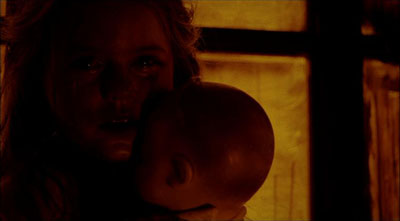
- So Björk sort of got off easy, in the sense that she didn't have to feign sexual ecstasy while leaning over the hood of a Volkswagon.
- Von Trier has a brief cameo, as the clerk at one of the film's many decaying hotels.

- His character is just as charming as he looks.
- The DVD also includes Tranceformer, a profile of Von Trier directed by Stig Björkman and Fredrik von Krusenstjerna. It was made while Von Trier was directing Breaking the Waves, and is notable for two reasons. The first is a clip of Von Trier saying, "Shall we skip the niceties and get on with the interview?" on camera, presumably after the interviewer asked him how he was doing or complimented his work. It's a nice passive-aggressive thing for the filmmakers to have included, in that it makes Von Trier look like a jerk. The second is the interview footage with Peter Aalbæk Jensen, who produced Breaking the Waves. Jensen appears to have modeled his on camera persona (Producer with a capital P!) after Orson Welles in The Muppet Movie.
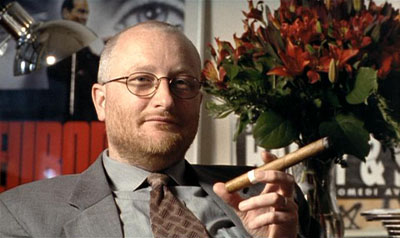
- The Element of Crime contains a nice example of the art direction colliding with the script. Throughout the film, we see copies of Osborne's monograph, The Element of Crime in various editions, from a leather-bound hardcover to an Arabic translation. The graphic design of each different version is well designed and appropriate; this is the kind of detail I really appreciate when filmmakers take the time to get right). But Osborne doesn't have a first name, which means that the trade paperback floating around the floor of Fischer's car looks a little unbalanced. Click the image for a full-sized version:
- Most awkward Freudianism in a film full of awkward Freudianim: Kim tells Fisher "I want to show you something," and the next shot is the two of them on a boat, sailing down a dark, wet passage.
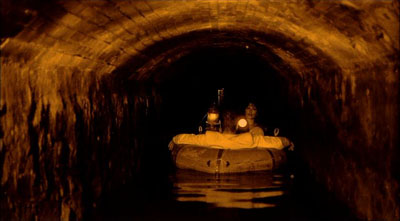
- Fisher's therapist says he's gone "down the drain... into the tunnel of love." Save us, Nabokov!
